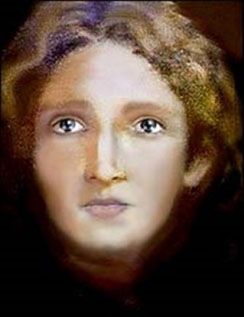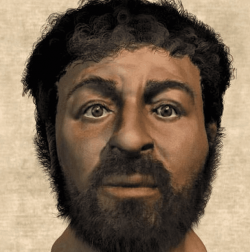Good evening,
The Shroud of Turin or Turin Shroud (Italian: Sindone di Torino, Sacra Sindone [ˈsaːkra ˈsindone] or Santa Sindone), a length of linen cloth bearing the image of a man, is believed by some to be the burial shroud of Jesus of Nazareth, although three radiocarbon dating tests in 1988 dated a sample of the cloth to the Middle Ages.The shroud is kept in the royal chapel of the Cathedral of Saint John the Baptist in Turin, northern Italy. The Catholic Church has neither formally endorsed nor rejected the shroud, but in 1958 Pope Pius XII approved of the image in association with the devotion to the Holy Face of Jesus.Pope John Paul II called the Shroud "a mirror of the Gospel".
The origins of the shroud and its images are the subject of intense debate among theologians, historians and researchers. Diverse arguments have been made in scientific and popular publications claiming to prove that the cloth is the authentic burial shroud of Jesus, based on disciplines ranging from chemistry to biology and medical forensics to optical image analysis. In 1988, a radiocarbon dating test dated a corner piece of the shroud from the Middle Ages, between the years 1260 and 1390, which is consistent with the shroud's first known exhibition in France in 1357.Articles published from 2000 - 2015 have highlighted concerns about this dating.Aspects of the 1988 test continue to be debated, but meaningful challenges to the dating result have so far been unsuccessful.According to Christopher Ramsey of the Oxford Radiocarbon Accelerator Unit in 2011, "there are various hypotheses as to why the dates might not be correct, but none of them stack up.
The image on the shroud is much clearer in black-and-white negative than in its natural sepia color, and this negative image was first observed in 1898 on the reverse photographic plate of amateur photographer Secondo Pia, who was allowed to photograph it while it was being exhibited. A variety of methods have been proposed for the formation of the image, but the actual method used has not yet been conclusively identified. Despite numerous investigations and tests, the status of the Shroud of Turin remains murky, and the nature of the image and how it was fixed on the cloth remain puzzling. The shroud continues to be both intensely studied and controversial.

------------------------------------------------------

The different stages of the rejuvenation of the face of Christ of the Holy Shroud.
The Italian Scientific Police used software to digitally rejuvenate the face of Christ reconstituted from the imprint on the Shroud of Turin.
The Italian police used the digital technology usually reserved for the wanted criminals and the children kidnapped to reconstruct the face of the christ child from the imprint of the shroud of Turin. In general, this sophisticated and reliable software is used to age the face in order to obtain for example the robot portrait of a mafia who has been on the run for years. The most famous case is that of a boss of the mafia, Bernardo Provenzano, identified and arrested in 2006. His digitally aged photograph of 1959 proved to be almost perfectly similar to his model.
This time, the process was reversed to find the traits of Jesus child, adolescent and young man: the size of the jaw was reduced, the chin refined and shaved, and the nose straightened on the assumption that the deviation of The nasal septum, visible on the face of the shroud, is due to late trauma.
Was Jesus really blond?
But this work of the scientific police, supervised by the ecclesiastical authorities, is already provoking criticism and sarcasm: for the New York Times, "this angelic face recalls the prayer cards sold to tourists in Vatican souvenir shops and portraits New Age made by the neo-hippies of Venice Beach ".

As for the scientist Paul Diamond, who participated in the carbon 14 dating of the shroud in 1998, concluding with a fake made in the thirteenth century, he sees it as a "foolishness," emphasizing that Jesus child was certainly not blond.
This re-enactment was carried out on the occasion of the exceptional exhibition of the Shroud, normally kept away from the gaze and outrages of time in a sealed container. The seven-meter long relic that would have contained the body of Christ will be visible for two months in the chapel near the Cathedral of Turin where the shroud is preserved.
Suaire de Turin - Le visage de Jésus enfant dévoilé
The Shroud of Turin or Turin Shroud (Italian: Sindone di Torino, Sacra Sindone [ˈsaːkra ˈsindone] or Santa Sindone), a length of linen cloth bearing the image of a man, is believed by some to be the burial shroud of Jesus of Nazareth, although three radiocarbon dating tests in 1988 dated a sample of the cloth to the Middle Ages.The shroud is kept in the royal chapel of the Cathedral of Saint John the Baptist in Turin, northern Italy. The Catholic Church has neither formally endorsed nor rejected the shroud, but in 1958 Pope Pius XII approved of the image in association with the devotion to the Holy Face of Jesus.Pope John Paul II called the Shroud "a mirror of the Gospel".
The origins of the shroud and its images are the subject of intense debate among theologians, historians and researchers. Diverse arguments have been made in scientific and popular publications claiming to prove that the cloth is the authentic burial shroud of Jesus, based on disciplines ranging from chemistry to biology and medical forensics to optical image analysis. In 1988, a radiocarbon dating test dated a corner piece of the shroud from the Middle Ages, between the years 1260 and 1390, which is consistent with the shroud's first known exhibition in France in 1357.Articles published from 2000 - 2015 have highlighted concerns about this dating.Aspects of the 1988 test continue to be debated, but meaningful challenges to the dating result have so far been unsuccessful.According to Christopher Ramsey of the Oxford Radiocarbon Accelerator Unit in 2011, "there are various hypotheses as to why the dates might not be correct, but none of them stack up.
The image on the shroud is much clearer in black-and-white negative than in its natural sepia color, and this negative image was first observed in 1898 on the reverse photographic plate of amateur photographer Secondo Pia, who was allowed to photograph it while it was being exhibited. A variety of methods have been proposed for the formation of the image, but the actual method used has not yet been conclusively identified. Despite numerous investigations and tests, the status of the Shroud of Turin remains murky, and the nature of the image and how it was fixed on the cloth remain puzzling. The shroud continues to be both intensely studied and controversial.
------------------------------------------------------

The different stages of the rejuvenation of the face of Christ of the Holy Shroud.
The Italian Scientific Police used software to digitally rejuvenate the face of Christ reconstituted from the imprint on the Shroud of Turin.
The Italian police used the digital technology usually reserved for the wanted criminals and the children kidnapped to reconstruct the face of the christ child from the imprint of the shroud of Turin. In general, this sophisticated and reliable software is used to age the face in order to obtain for example the robot portrait of a mafia who has been on the run for years. The most famous case is that of a boss of the mafia, Bernardo Provenzano, identified and arrested in 2006. His digitally aged photograph of 1959 proved to be almost perfectly similar to his model.
This time, the process was reversed to find the traits of Jesus child, adolescent and young man: the size of the jaw was reduced, the chin refined and shaved, and the nose straightened on the assumption that the deviation of The nasal septum, visible on the face of the shroud, is due to late trauma.
Was Jesus really blond?
But this work of the scientific police, supervised by the ecclesiastical authorities, is already provoking criticism and sarcasm: for the New York Times, "this angelic face recalls the prayer cards sold to tourists in Vatican souvenir shops and portraits New Age made by the neo-hippies of Venice Beach ".

As for the scientist Paul Diamond, who participated in the carbon 14 dating of the shroud in 1998, concluding with a fake made in the thirteenth century, he sees it as a "foolishness," emphasizing that Jesus child was certainly not blond.
This re-enactment was carried out on the occasion of the exceptional exhibition of the Shroud, normally kept away from the gaze and outrages of time in a sealed container. The seven-meter long relic that would have contained the body of Christ will be visible for two months in the chapel near the Cathedral of Turin where the shroud is preserved.
Suaire de Turin - Le visage de Jésus enfant dévoilé









